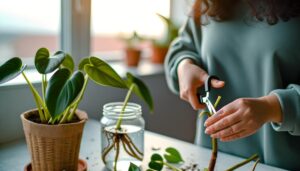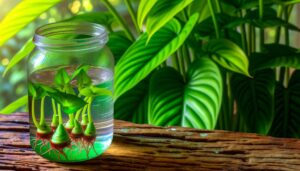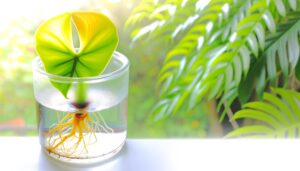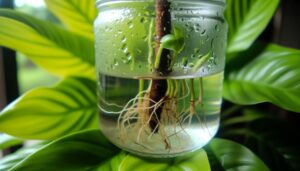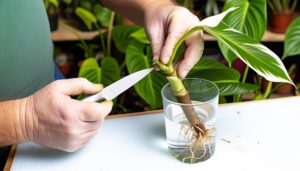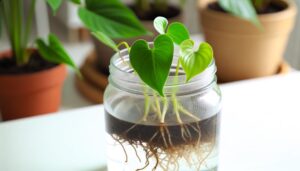Propagate Philodendron Monstera Without Node Water
Propagating Philodendron Monstera without a node in water is challenging because nodes are critical for root initiation and nutrient uptake. Nodes house meristematic tissues necessary for rooting.
When propagating, select stem sections with visible nodes to maximize successful root formation. Submerge the node in a sterilized, clear container of distilled water, and use rooting enhancers to promote growth.
Changing the water regularly prevents stagnation and contamination. Providing bright, indirect light and maintaining ideal humidity will enhance rooting conditions.
For further insights into the propagation process and to promote vigorous plant growth, more detailed information is available.
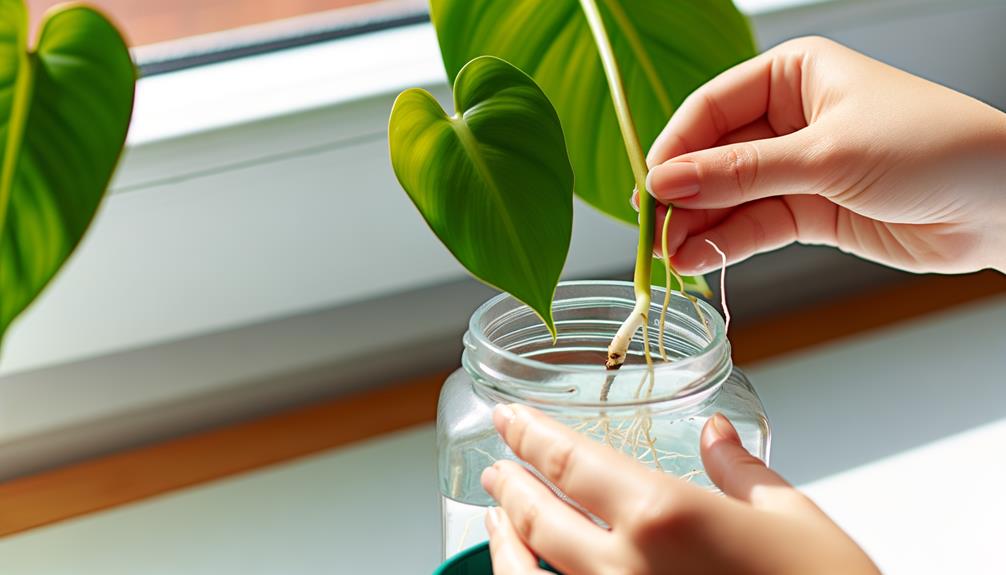
Key Takeaways
- Philodendron Monstera cannot be propagated successfully without a node, as nodes are essential for root development.
- To propagate, ensure each cutting includes at least one node for root formation.
- Use sterilized pruning shears to make clean cuts below the node on a healthy stem.
- Place the cutting in a clear container with distilled water, ensuring the node is submerged.
- Change the water regularly to prevent stagnation and support healthy root growth.
Understanding Monstera Propagation
Monstera propagation is a vital horticultural practice that involves the strategic reproduction of Monstera plants through methods such as stem cuttings. This guarantees genetic consistency and promotes healthy growth. This technique necessitates selecting a healthy mother plant, from which a cutting is taken just below a node. Nodes are pivotal as they harbor meristematic cells responsible for root development.
The cutting should include at least one leaf and one node, ensuring optimal photosynthetic activity and root formation. Proper sanitation of cutting tools is imperative to prevent pathogenic infections. Following excision, the cutting should be allowed to callus, reducing rot risk. This preparatory phase underscores the importance of understanding Monstera's biology to achieve successful propagation outcomes.
Essential Tools and Materials
To effectively propagate Philodendron Monstera without utilizing node water, it is important to employ accurate cutting tools such as sterilized pruning shears to prevent contamination.
Selecting a suitable water container is ideal, with glass jars being best for monitoring root development.
Additionally, incorporating root-boosting additives like liquid seaweed extract can greatly enhance root formation and overall plant health.
Necessary Cutting Tools
When preparing to propagate Philodendron Monstera without a node, it is important to utilize sterilized, sharp cutting tools such as pruning shears or a fine-tipped scalpel to guarantee clean cuts and prevent infection. Ensuring that tools are properly sanitized reduces the risk of introducing pathogens that may compromise the plant tissue.
Essential cutting tools include:
- Pruning Shears: Ideal for making precise cuts on thicker stems.
- Fine-Tipped Scalpel: Provides accuracy for delicate cuts.
- Sterilizing Solution: Necessary for disinfecting tools before and after use.
- Cutting Board: A clean surface to support the plant during the cutting process.
Water Container Selection
Selecting a suitable water container is essential for ensuring the best environment for root development in Philodendron Monstera cuttings. The container should be see-through to facilitate monitoring of root progress and water clarity. Glass or clear plastic vessels with a wide opening are recommended to allow easy placement and removal of cuttings without damaging tender roots.
The container's depth should be sufficient to submerge the cutting's nodes while maintaining stability to prevent tipping. Containers should be sterilized prior to use to minimize bacterial contamination. Regular cleaning and water changes are necessary to create an ideal environment, preventing pathogens and promoting healthy root growth.
Root-Boosting Additives
Incorporating specific root-boosting supplements, such as liquid rooting enhancers and beneficial microorganisms, can greatly enhance the root development process in Philodendron Monstera cuttings. These supplements accelerate cellular differentiation and enhance root strength, leading to more robust plant growth.
Essential tools and materials include:
- Liquid Rooting Enhancers: Contain auxins like indole-3-butyric acid (IBA) to stimulate root initiation.
- Beneficial Microorganisms: Mycorrhizal fungi and beneficial bacteria improve nutrient uptake and root health.
- Sterilized Blending Medium: Ensures a pathogen-free environment, optimal for cutting success.
- pH Balancing Solutions: Maintain best pH levels in the rooting medium to promote nutrient absorption.
Utilizing these scientifically-proven supplements prepares the cutting for successful transplantation and vigorous growth.
Choosing the Right Cuttings
When selecting cuttings for propagating Philodendron Monstera, it is crucial to identify healthy stems exhibiting robust growth and vibrant coloration. Avoid stems with damaged or diseased leaves, as these can undermine the success of propagation.
Additionally, make sure the cuttings are of appropriate length, ideally between 4 to 6 inches, to provide ample energy reserves and surface area for root development.
Identify Healthy Stems
To optimize the propagation success of Philodendron Monstera, it is crucial to identify healthy stems by examining the presence of robust, disease-free tissue and multiple nodes. Selecting the right cuttings guarantees the plant's ability to develop roots effectively and thrive in a new environment.
When choosing cuttings, consider the following criteria:
- Node Presence: Confirm each cutting has at least one node, as nodes are crucial for root formation.
- Stem Integrity: Choose stems that are firm and free from any signs of rot or pest damage.
- Leaf Attachment: Prefer cuttings where leaves are attached close to the node; this enhances photosynthesis efficiency.
- Vigorous Growth: Opt for stems that exhibit vigorous growth patterns, indicating overall plant health.
Avoid Damaged Leaves
Choosing cuttings with undamaged foliage is crucial for successful Philodendron Monstera propagation, as compromised leaves can impede the plant's ability to photosynthesize effectively and recover from the stress of cutting. Healthy leaves, free from discoloration, tears, or pests, ensure ideal energy production and nutrient transport. Prior to cutting, carefully examine each leaf, taking note of these key indicators:
| Indicator | Healthy Leaf Characteristics | Compromised Leaf Signs |
|---|---|---|
| Color | Even green color, vivid pigmentation | Yellowing, browning, or spotting |
| Texture | Silky, robust, turgid | Wilting, soft, or dry |
| Edges | Whole, intact | Torn, frayed, or chewed |
Selecting cuttings based on these criteria maximizes the chances of successful root development and overall plant vitality, thereby boosting propagation success.
Select Proper Length
Determining the best length for Philodendron Monstera cuttings is essential for maximizing successful root initiation and subsequent growth. Optimal cuttings should be carefully selected to balance nutrient reserves and surface area for root development.
Here are four key guidelines:
- Length: Aim for cuttings that are 4-6 inches (10-15 cm) long. This length provides sufficient energy reserves while minimizing water loss.
- Nodes: Ensure the cutting includes at least one node, as nodes are vital sites for root development.
- Leaves: Retain 2-3 leaves on the cutting to enable photosynthesis, but avoid overcrowding to reduce transpiration.
- Stem Health: Choose cuttings with firm, green stems free from rot or mechanical damage to enhance propagation success.
These criteria collectively maximize the potential for robust and healthy propagation.
Preparing the Cuttings
Maximizing the successful propagation of Philodendron Monstera requires the careful selection of healthy stem segments, ideally containing at least one aerial root. Begin by sterilizing cutting tools with isopropyl alcohol to prevent microbial contamination.
Identify a robust stem section that exhibits vibrant, unblemished foliage and a visible node. Using sterilized shears, make a clean cut approximately 1-2 inches below the node. This ensures the cutting retains sufficient tissue for nutrient uptake and root development.
Remove any lower leaves to expose the node, facilitating optimal water absorption. Inspect the cutting for signs of disease or pest infestation, discarding any compromised material. Proper preparation of cuttings maximizes the likelihood of successful root initiation and subsequent growth.
Water Propagation Basics
To initiate successful water propagation of Philodendron Monstera, selecting an appropriate container is paramount, ensuring it accommodates the cutting without submerging the leaves.
Regular water changes are critical to prevent stagnation and microbial growth, which can inhibit root development.
Utilizing distilled or rainwater can optimize conditions by minimizing the introduction of harmful chemicals and pathogens.
Choosing Right Container
Selecting an appropriate container for water propagation is crucial as it directly influences the oxygenation, stability, and overall health of the Philodendron Monstera cuttings. Choosing the right vessel ensures peak root development and prevents anaerobic conditions detrimental to plant health.
Consider the following:
- Size: Containers should be large enough to accommodate the cutting without overcrowding, allowing ample space for roots to expand.
- Material: Glass containers are preferable as they allow light penetration, facilitating photosynthesis and root observation.
- Shape: Opt for narrow-mouthed containers to stabilize the cutting, minimizing movement that could hinder root growth.
- Cleanliness: Guarantee the container is sterile to prevent microbial contamination that could cause root rot.
These factors collectively contribute to a conducive environment for successful water propagation.
Changing Water Regularly
Regularly changing the water in your propagation container is essential to maintaining peak oxygen levels and preventing the buildup of harmful pathogens that can hinder root development. To achieve this, replace the water every 3-5 days.
Use dechlorinated or distilled water to reduce the risk of chlorine-induced stress. Make sure the water temperature is consistent with room temperature to avoid sudden temperature changes.
Clean the container thoroughly during each water change to remove biofilm and algae that may harbor bacteria. Monitor the water clarity; any discoloration or odor indicates the presence of contaminants.
This meticulous approach guarantees a sterile environment, promoting strong root growth and enhancing the overall success rate of propagating Philodendron Monstera.
Creating the Ideal Environment
Establishing the perfect conditions for Philodendron Monstera propagation without nodes involves carefully managing factors such as humidity, temperature, and light intensity. This promotes optimal cellular activities and root initiation processes.
To create the ideal environment, consider the following:
- Humidity: Maintain a relative humidity level between 60-80% to prevent dehydration and enhance root formation.
- Temperature: Keep the ambient temperature within the range of 20-25°C (68-77°F) to support enzymatic activities and growth.
- Light: Provide indirect, bright light to facilitate photosynthesis without causing light damage.
- Air Circulation: Ensure sufficient air flow to reduce fungal growth and promote gaseous exchange.
These parameters are crucial in establishing a favorable environment for successful propagation.
Monitoring Root Development
To accurately monitor root development in Philodendron Monstera, it is essential to periodically assess the cutting for signs of root initiation and elongation using both visual inspection and gentle tactile evaluation. Examine the cutting every 7-10 days, looking for emerging root primordia which appear as small, white protrusions.
Use a sterile technique to gently feel the base of the cutting, ensuring no damage occurs to developing roots. Record observations meticulously, noting root length, color, and any signs of rot or fungal infections. Employ magnification tools if necessary to enhance visibility.
Consistent environmental conditions, such as humidity and temperature, should be maintained to optimize root growth. Regularly updating these metrics facilitates informed decisions for the next stages of propagation.
Transferring to Soil
Once the roots of the Philodendron Monstera cutting have reached approximately 1-2 inches in length, it is best to transfer the cutting into a well-draining soil medium to support further growth. This shift guarantees ideal nutrient uptake and sustained root development.
Follow these steps:
- Select an suitable potting mix: Utilize a blend containing peat, perlite, and orchid bark for aeration and moisture retention.
- Prepare the container: Choose a pot with drainage holes to prevent waterlogging, which can lead to root rot.
- Plant the cutting: Make a small hole in the soil and gently place the cutting, ensuring the roots are fully covered.
- Water appropriately: Moisten the soil evenly, avoiding over-saturation, to maintain a stable microenvironment conducive to growth.
Common Mistakes to Avoid
A critical error often made during the propagation of Philodendron Monstera is the failure to properly identify and utilize nodes in the cutting process. Nodes contain meristematic tissue critical for root development. Misidentification leads to non-viable cuttings, wasting resources and time. Additionally, excessive leaf removal reduces photosynthetic capability, impeding growth. Overexposure to direct sunlight can also stress cuttings, causing dehydration and reduced root initiation. Using contaminated tools introduces pathogens, increasing infection risks.
| Common Mistake | Consequence |
|---|---|
| Incorrect node recognition | Non-viable cuttings |
| Excessive leaf elimination | Reduced photosynthesis |
| Overexposure to sunlight | Dehydration and stress |
| Contaminated equipment | Pathogen introduction |
| Inadequate water sanitation | Impaired root development |
Understanding these pitfalls guarantees successful Philodendron Monstera propagation.
Tips for Healthy Growth
Maintaining an ideal environment for Philodendron Monstera cuttings involves keeping high humidity levels, which support strong root development and overall plant vigor. Achieving prime conditions requires attention to several key factors:
- Humidity: Sustain relative humidity between 60-80% using humidifiers or misting. This microclimate supports root initiation.
- Light: Offer bright, indirect sunlight. Avoid direct exposure, which can result in leaf burn and hinder growth.
- Temperature: Maintain ambient temperatures consistent, ideally between 20-25°C (68-77°F), to ensure metabolic efficiency.
- Soil Composition: Utilize a well-aerated, well-draining medium composed of equal parts peat moss, perlite, and pine bark. This mixture prevents waterlogging and enhances root aeration.
Following these guidelines nurtures a favorable environment for robust Philodendron Monstera growth.
Conclusion
In summation, the propagation of Philodendron Monstera via water without nodes necessitates careful attention to detail. Employing a combination of precise cutting selection, proper preparation, vigilant monitoring, and adept changeover to soil guarantees successful root development and plant health.
Neglecting these steps is akin to moving through a maze blindfolded, where each misstep can lead to failure. Mastery of these techniques facilitates the thriving of this enchanting species, contributing to its lush legacy in horticultural pursuits.

